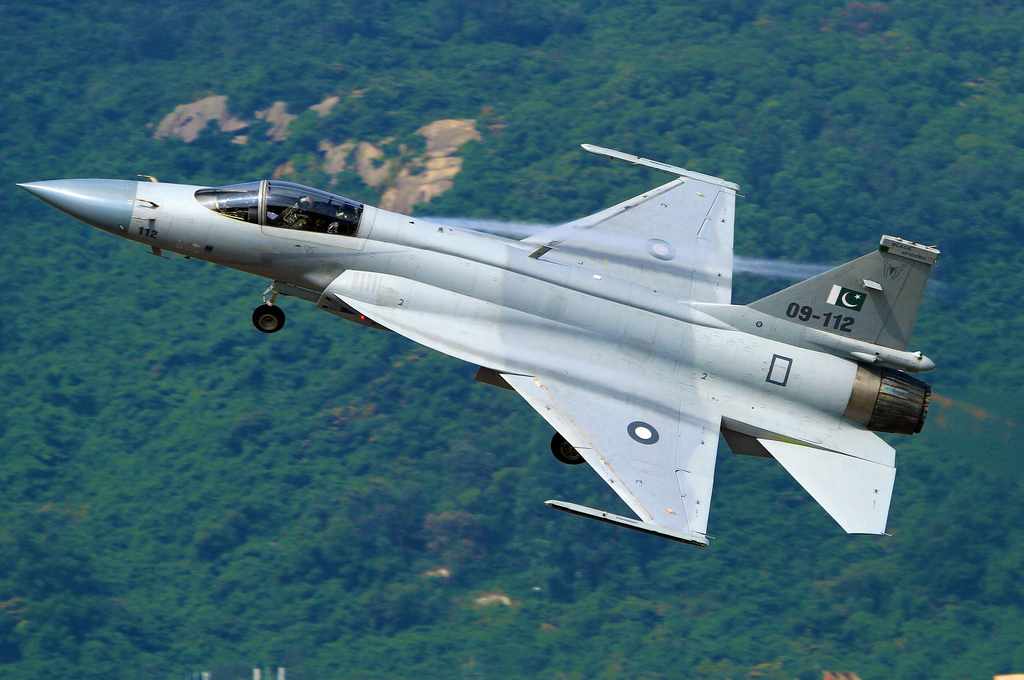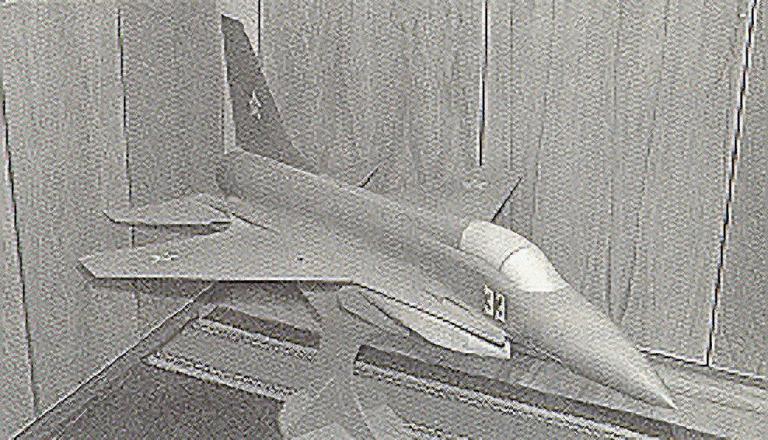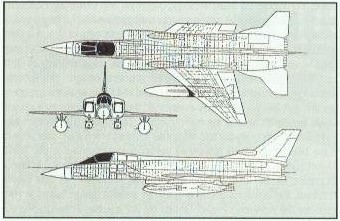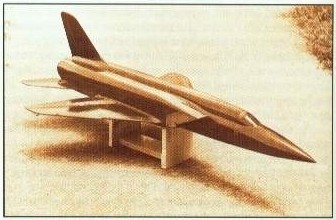
By Mihir Shah
In early 2007, when the first production JF-17 “Thunder” fighter was unveiled to the Pakistani public, it failed to make much of an impression outside the Indian subcontinent. And for good reason. As a twenty-first century fighter aircraft, it appeared rather unremarkable; pedestrian, almost. It boasted neither the sleek lines of the F-16, nor the raw power of the MiG-29. Its capabilities could best be described as middle-of-the-road.
Ten years on, the aircraft has acquired a history that belies its purported mediocrity. It has performed at air shows in Paris and Dubai; flown ground-attack sorties against the Tehrik-i-Taliban Pakistan in Operation Rah-e-Nijat; and bid for export contracts to multiple nations, albeit unsuccessfully for the time being.
To the casual observer, these accomplishments might come across as modest. But given the backdrop of the jet’s humble origins and its troubled development, they stand out as anything but.
Imported Thunder
The popular narrative is that the JF-17 is a development of the 1980s-era Super 7 project—a collaborative effort between China’s Chengdu Aircraft Corporation and US-based Grumman Aerospace—aimed at equipping China’s air forces with a low-cost fighter outfitted with American avionics. The Super 7 was based on the J-7, which itself was a Chinese copy of the iconic MiG-21 interceptor. When the United States pulled out of the venture following the 1989 Tiananmen Square Massacre, Chengdu pursued the programme on its own under the “Fighter China” label, swapping out its American components for Chinese and Russian ones.
However, there is also some reason to believe that it descended from a Soviet research initiative that never saw the light of day: the Izdeliye 33. The latter was conceived as an advanced single-engine counterpart to the F-16 Fighting Falcon, and shared a limited degree of commonality with the twin-engine MiG-29. China is said to have purchased the design from Russia after the collapse of the Soviet Union, and incorporated many of its elements into its Fighter China project. The truth probably lies somewhere in between. There is no denying the similarity in appearances between it and the Izdeliye 33. The Super 7 and J-7 lineage, too, is unmistakable.

In the mid-1990s, the design was offered to Pakistan as a “joint project”, although Pakistan’s contribution was limited to funding its development and then manufacturing the final product at a state-owned facility in Kamra. Russia’s Mikoyan Design Bureau was also roped in as a consultant. Designated the FC-1 “Xiaolong” by China and JF-17 “Thunder” by Pakistan, the aircraft was initially intended to be equipped with Western avionics, weapons, and displays. However, efforts to procure these subsystems fell through, and they were replaced with their Chinese counterparts instead. The initial prototype undertook its first flight in May 2003. The first production aircraft arrived in Pakistan in March 2007, and series production commenced in June 2009.
Practical, not Perfect
From a cursory look at its performance specifications, the JF-17 appears to be a mediocre aircraft. It doesn’t fly particularly fast, or exhibit a spectacular turn rate, or possess an outstanding thrust-to-weight ratio. The Russian-made Klimov RD-93 engine that powers it is notorious for its short life and lack of reliability. The avionics package and weapons suite are austere by modern standards. It lacks a fly-by-wire flight control system: a vital piece of technology that is present on practically every modern fighter. So lacklustre is its performance that the country that led its development—China—isn’t inducting a single unit of the type.
And paradoxically, this lack of sophistication is probably what makes the Thunder a useful component of Pakistani air power. It is not a world-beater, but a moderately capable platform that could occupy an important position within a larger warfighting framework. In today’s networked battlefield, a flight of JF-17s—armed with a mix of medium and short range missiles, supported by an airborne early warning and control platform, and protected by land-based air defences—could conceivably hold its own against most offensive sorties launched against Pakistani airspace. In the ground attack role, the aircraft’s ability to drop precision-guided bombs on weakly defended targets could free up Pakistan’s more capable F-16 fleet to tackle more challenging assignments, at the very least.
More importantly, the aircraft’s affordability and relative simplicity allow a cash-strapped Pakistan to procure it in numbers (more than eighty airframes are already in service). While it is a Chinese design, it does give Pakistan some experience in fighter manufacture; and without intellectual property considerations weighing down further development, Pakistani engineers are free to modify and upgrade it in any way they see fit.
Whither Tejas?
The Thunder’s unexceptional design, although more a product of circumstance than careful planning, does offer important lessons for India’s own aerospace development efforts. When its development appeared to be in trouble on account of the failure to procure avionics and weapons from Western suppliers, its managers quickly substituted them with their less-capable Chinese equivalents, even though immediate-term performance suffered. In doing so, they chose to prioritise what was truly important: low cost, reduced development risk, and the ability to quickly shore up numbers.
In contrast, the Indian Air Force (IAF) and scientific establishment took the opposite route with the Tejas Light Combat Aircraft (LCA) programme. In chasing capability as an end in itself, they permitted the project scope to expand unchecked, thus transforming what started off as a modest, lightweight, point-defence interceptor into a fourth-generation multirole fighter. The Tejas is undoubtedly more capable than the Thunder, but it is also more complex, and that complexity has always been its Achilles Heel. The time and cost overruns born out of this complexity have brought the project under heavy criticism from government auditors, and inordinately delayed Final Operational Clearance—a crucial milestone that declares an aircraft fully ready for combat.
Thus, while the Tejas is yet to fully equip a single IAF unit, the Thunder has entered frontline service in Pakistan, equipping five operational squadrons. Chinese development agencies are also working on a slew of upgrades to enhance its combat potential. These include an active electronically scanned array (AESA) radar to serve as its primary sensor, a helmet mounted sight to cue short-range missiles, and a sea-skimming anti-ship missile intended for use in the maritime strike role.


The Thunder’s success offers useful insight into what India’s military and scientific leadership could have achieved had it limited its ambitions with the LCA, or chosen not to short-sightedly terminate the HF-24 Marut programme. No doubt the Marut had its share of issues, but so did its replacement—the Anglo-French Jaguar. Unlike the Marut though, it has, over its long service life, been steadily upgraded in-house by Hindustan Aeronautics Limited. Its most recent upgrade package, featuring an Israeli AESA radar, makes it a formidable fighter-bomber in its own right. Had the same been done with a Marut derivative, the aircraft could conceivably have formed the backbone of the IAF’s fighter fleet, and conferred it with more capability than the MiG-21 Bison does today. Furthermore, the effort would have dovetailed perfectly with the LCA and AMCA programmes; in the process spawning a knowledge base and industrial ecosystem capable of reducing many of the risks associated with developing a complex aeronautical product from scratch.
Mihir Shah is a mechanical engineer who tracks military and aerospace issues closely. He contributes to to LiveFist, Pragati Magazine, and Bharat Rakshak’s Security Research Review.

Interesting article about and aircraft that is simply a target and not much more. Poor engines, poor electronics and poor situational awareness does not make a combat aircraft.
why it took 17 years just to fire bvr missile that too with foreign radar from tejas.
Although the article describes attempts to export the JF-17 as so far unsuccessful, it’s sale to two countries is more or less confirmed.
Myanmar: http://www.janes.com/article/71422/images-show-myanmar-air-force-jf-17-fc-1-conducting-flight-tests-in-china
Nigeria: http://quwa.org/2017/01/04/official-2016-nigerian-budget-confirms-jf-17-order/
Nicely written
Great article. “Affordability ” and “local expertise development” are key to being a great military power. Indian Airforce however seems to have none of these and today if someone has to be blamed for shortage of squadrons it is themselves. They seem to have learnt nothing : still talk of great things for AMCA, am sure it will never come out .
. I hope the government forces these guys to be realistic for ongoing manned and unmanned next generation aircraft.
These guys make our prime minister look like an idiot when he goes to negotiate something (now affordable single engine fighter). Poor guy.
Mihir, we have enough firepower from abroad. What we want to achieve from Tejas is self sufficiency in building latest generation fighters. We already have the pieces in place now to develop a more advanced AMCA and HAL is slowly moving onto becoming a SI which is what its role should be, leaving the mundane parts manufacturing to good private players.
Ha ha ha ha
Very well researched article which gives an insight into pakistan air force capabilities and hints HAL to gear up for the future!
egypt getting 50 mig 35 for 2 billion while our country paid 2 billion just to upgrade 50 mirages.
Hal is slow in everything even failing to productionize lca,mki to a good numbers there is no shortage of workers in country.
Country does not have its own priorities , but likes getting looted.
Interesting Fact: The Joint-Fighter 17 (JF-17) is the Pakistani nomenclature for this jet, signifying the “joint” effort of Pakistan and China in developing it. However, the Chinese insist on terming it the Fighter-China 1 (FC-1), with no mention of Pakistan ! Its a sorry state of affairs for the Chinese pseudo-colony Pakistan, and a lesson which we must learn vis-a-vis the PAK-FA and the locally termed “FGFA” (or whatever).
The JF-17 was an desperate effort by a Pakistan hemmed in by global sanctions. Finding a small hope in China, it immediately latched on to this project as a financier. Originally meant to be a hybrid between a J-7 and a MiG-29 (more like a single-engined MiG-29), Pakistan was rumoured to have supplied its F-16s to China so that they could study its design. This probably explains the distinctly F-16-ish wing shape and fuselage.
The fact that the engine is the RD-93, is more a result of Russia’s definitive involvement in the project, than any sly wrangling by Pakistan to obtain a western engine in the face of sanctions.
The JF-17’s design has another curious aspect of the so-called DSI intakes. Nobody knows how effective these are, but they’re supposed to reduce fuel consumption and increase maneuverability.
I agree with Mihir Shah that its a mediocre jet at best. Its a very advanced MiG-21 or MiG-29, and can be the workhorse of the 21st century. Its cheap, and pretty much does what it promises. It’s radar is a traditional mechanically steered one, and its FBW is present only in the pitch axis (the yaw and roll axes have an analog-type (?) reflex system.
However, what is really appreciable is the staunch and stolid support of the PAF and the Pakistani public and media for this, no matter however it is. Desperate times do call for a concerted zeal, and the JF-17 is a good example of that. Contrast this with a former IAF chief, who comes on National TV to deride the Tejas. Or the ToIs and HTs of India, which never miss a chance to berate the Tejas’ with the “30 years in the making” taunt. These fat cats in the IAF and media need to learn a lot from their Pakistani counterparts.
P.S: The “17” in JF-17, I was told by Pakistani fora members is a continuation of their beloved F-16.
The Tejas vs JF-17 comparison seems to evoke memories about the Panzer vs T34. T34 was considered by the Germans to be too crude and simple. The Panzer on the other was highly sophisiticated and no doubt more lethal. But Stalin, true to his belief that “quantity has a quality of its own” overwhelmed the German army by producing the T34 in large numbers QUICKER, whihc means for every destroyed tank, the time to churn out its replacement was shorter. The Panzer on the other hand, due to it’s sophistication, took a much longer to time to assemble. The T34 was major factor in confounding Hitler’s plans. Let’s hope that Tejas doesn’t suffer a similar fate. MAKE ease of production AS PART OF THE SQRs.
IAF has been notoriously slow in reverse engineering or suppprting indigenous development by trying to have all eggs in one box instead of going for incremental upgrades
we stand nowhere in passenger airliners assembly , neither congis nor modi have any plans in this regard
In today`s modern combat environment a fighter aircraft is just a platform, turn rates, Gs and Fly-by-wire systems don`t matter as they mostly engage in BVR. You can keep loading these aircraft platforms with off the shelf equipments like radars,ECMs, and missiles. So, at times simplicity and quantity matters, especially for support and defence fighters. In fact this was the soviet strategy for fighters like Mig 29. They deliberately made the Mig29s less sophisticated with a shorter range as they were defensive fighters.
Its also a question of hubris. While Pakistan seeing an existential threat that had cut it in half in the past on its Eastern border, is desperate to defend itself by any means possible India suffers no such fear. So delivery rather than capability is an end for the Pak military which it has successfully prosecuted with the JF17 and the Al Khalid Tank – both good examples of jugaad. In contrast the Tejas and Arjun were not chasing Sasta Sundar aur Tikau but trying to develop self-reliance with technology that was slightly behind the best available to the region. While we can admire the down-to-earth approach of the Pakistanis deploying the airborne equivalent of an AK47 to defend its skies, we should have no doubts that the loftier goal of a 4 Gen Tejas was rightfully set. Its a different issue we may not have the depth of knowhow or Industrial strength to quickly deploy a Tejas but chasing an FC1/JF17 like target would have been wrong for India. A better example to look at for comparison is China – which has leapfrogged in Gen 5 technologies. We have to look above us, not over our shoulders.
Clearly a biased article, written to satisfy little egos of Indians.
Well I have red many articles but have never red an article so biased. Writer is comparing the aircraft with high performance, state of the art aircrafts which have been in service for decades and have a history of century. But he has failed to mention the point, that these aircrafts, be it JF17 or Teja are an effort by respective countries in the direction of aircraft manufacturing and that’s what they stand for. You better compare these aircrafts with each other or aircrafts coming from other developing countries. There is no doubt about this, that both of these aircrafts are not A class, but B plus aircrafts and have room for improvements. Either writer is naive or very bigoted, if you as writer can point out the short comings, those setting in aerospace and aircraft research manufacturing plants would’t know about it ? Well off course they do, but as evolution it’s a slow and gradual process of development. And the next generation of these aircraft’s might not have some of these short comings. Also from my understanding comparing the two, no matter how copied from where JF17 appears to be doing better than Teja.
This article is written by Indian and it is reflected in clear bias. Author has his views about the first make of JF 17 built and inducted 10 years before. With block 3, an advanced version of JF17 this aircraft can be compared to any modern aircraft of the world with much reduced cost. This is so why many countries including European Air Forces are considering inducting this aircraft.
Be interesting to read a non-biased Pakistani article shorn of national ego – do share. Your compatriot below says “certain” European countries want to buy a Thunder!
facts got wrong in this article, analysis i wont argue as that is the writer opinion
1. it has two export customers
2. new version has quadruple fly by wire(JF-17B already in production) and AESA(block 3 radar already selected and in testing)
3. can deploy all sort of weapons BVRs, WVRS, laser guided, cruise miss, antiship,has next gen turkish pod integrated
4. thrust tow eight ratio is ~1 and is FAR BETTER and lighter THAN TEJAS
5. Pakistan is producing 80% of avionics some completely indegnious from previous experience with grifo and 60% airframe
I have no doubt , Pakistan and China outsmart India in fighter development. LCA Tejas is superior to JF-17 but Pakistan and China’s approach and strategy is much smarter than us. Tejas program start in 1983 but even in 2018 , it still not complete. JF-17 start in late 1990s , now it is completed and going to next phase JF-17 block 2 block 3 etc.
If our government start doing same thing in 1983 , get the Mig-33 design from USSR and developed it. Than we have hundreds of fighters serving in front line.
Well seems the article is written with low to no research and inferences are simply drawn with intentions of painting JF17 as success story which is not the case. Has it been so I suppose Indian SU30 MKI which is licensed produced, overhauled and modified with in india by HAL, even Indians helped Malaysia in their SU30MKM configuration. But SU30MKI was never claimed by india in very way an aircraft with filler role is being done. Please care to understand the kind of industries and subsystems which are developed in the process of developing indigenous products have been created with in India.
FYI the first flight of tejas was conducted in year 2001, and their are parallel variants like twin seater and Naval which exist. in my eyes its not at all bad.
For a big economy like India, with huge defence budget its easily afforded and is the right way to go forward.
but there is always scope for improvements that includes the HAls production rate, Airforce inclination towards foreign toys and politics.
Had it been a product of China or Pakistan this very plane in its current state would have been inducted and given all clearances and one would have never heard any criticism from own agencies or people (simply matter of pride and ego) where as India is a true democracy and everyone has right to even criticize and question concerned authorities.
Please understand in comparison of JF17 which is a front line fighter , Tejas serves a role of a point defence figher be it land or carrier.
so even if One ‘assumes’ both fighters are similar in capabilities one is a premier front line fighter of a country and another just a interceptor .
Now that actually shows the state of economy of the two countries, where Pakistan runs on loans from Middle-east , China and IMF. Where as thats not the case with India with its huge foriegn reserves.
Bottom line,
– JF17 is just a filler (with pride and ego of surrogate country, the mother country doesnt care to use it because it doesnt fit any where for China) to raise numbers in a force and I will say its better than having nothing.
-The platform of JF17 has low scope of evolution and its almost or will soon be saturated. It just serves the present. (Not like a F16 which despite being now vintage is almost very good contemporary fighters in its newer blocks, or even Grippen which is still evolving )
– Not a very good export option eithers Saudis still have lots of money they will rather buy a Rafal or EF. and countries like Bangladesh are already operating likes of MiG29. Countries with economies smaller than that of Bangladesh might not even need even such figher aircrafts.
So when we say JF17 is a very good Aircraft its an excellent aircraft for Pakistan which has no other options right now.
LOL
You can keep on writing such moronic articles. It’s similar to masturbating. But it isn’t gonna change the fact that the Thunder block 1 was 70% F-16 in it’s capabilities as per the American aviation experts(google it). While the block 2 even exceeding earlier F-16s. And the block 3 even more interesting
It was made to replace Pakistan’s aging F-7 and Mirage inventory and JF-17 is the BEST most cost effective technologically superior solution for it and kudos to the PAF leadership for coming up with such a perfect solution
PLUS,it’s all Pakistani…..means, PAF can do any modifications they wish and install any weapon systems they like(they couldn’t do this to the F-16)
Doesn’t matter if no country bought it or didn’t buy it. We have 100+ JF-17 units in our inventory and we are gonna have hundreds more.(2 countries purchased it BTW)
What happened to the 6th generation Taj-ass by the way?
Poor Indians. Keep on masturbating at such moronic articles.
BTW,what happened to that 6th generation Taj-ass of yours? And what are you gonna do with those 7th generation flying coffins that makes up more than a half of your air force?
Indians can say what ever they want but they can never deny the fact that JF 17 a 3 1/2 gen aircraft is replacing F7 and out dated mirages that are at best a 2nd gen without modifications. On the other hand IAF’s aging MIG inventory is still a gaping hole and modi sarkar is trying to put a bandade of the 38 French Rafaels. IAF still is a desperate need of 45 operational squadrons to fulfill its land mass requirements and with 32 operational squadrons and that also have more then 10 of aging MIGs ( mostly the Bisons). You can say what ever you want but a JF thunder in the potent hands of a killer pAF pilot can do what a MKI cannot do by the hands of a IAF pilots. Just look at the facts and you will find out that IAF has the highest non war time casualty ratio of 6-7 aircrafts per every 100,000 flying hours as compact to 3-4 as NATO standards.